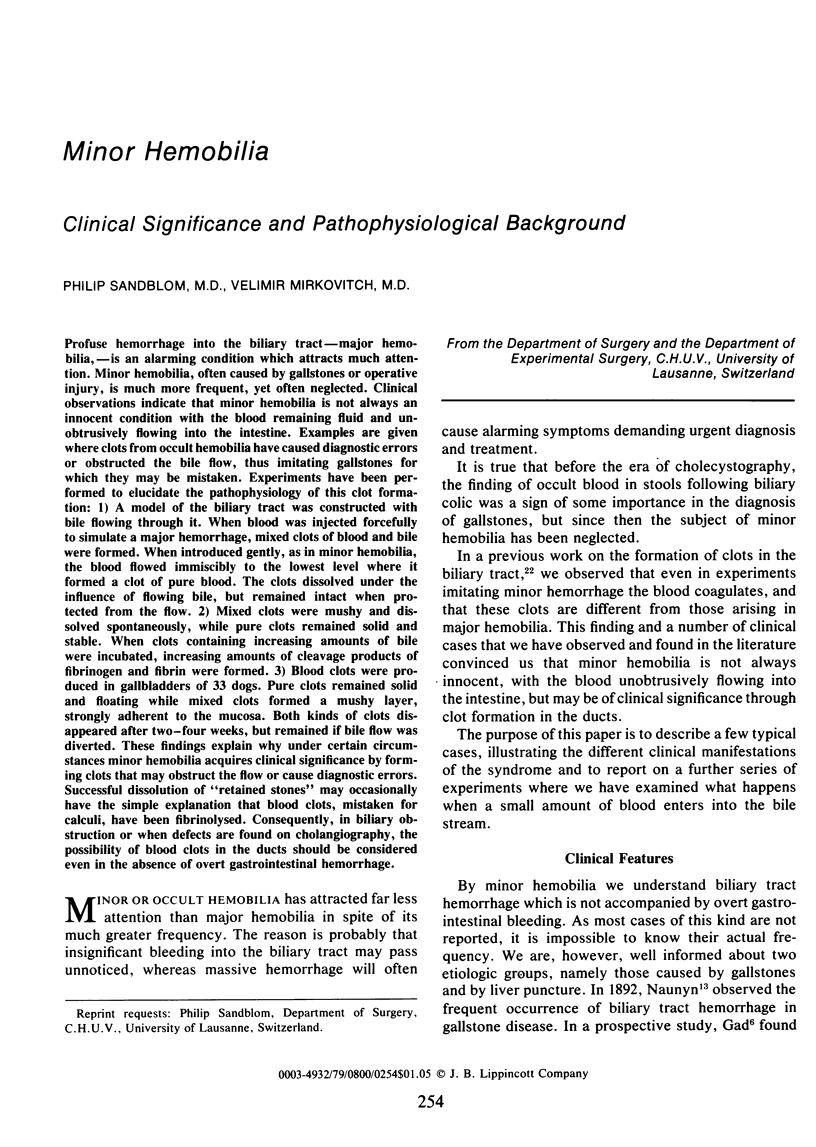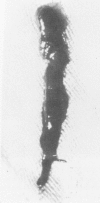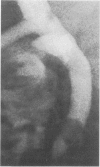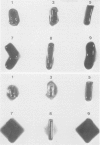Abstract
Profuse hemorrhage into the biliary tract--major hemobilia,--is an alarming condition which attracts much attention. Minor hemobilia, often caused by gallstones or operative injury, is much more frequent, yet often neglected. Clinical observations indicate that minor hemobilia is not always an innocent condition with the blood remaining fluid and unobtrusively flowing into the intestine. Examples are given where clots from occult hemobilia have caused diagnostic errors or obstructed the bile flow, thus imitating gallstones for which they may be mistaken. Experiments have been performed to elucidate the pathophysiology of this clot formation: 1) A model of the biliary tract was constructed with bile flowing through it. When blood was injected forcefully to simulate a major hemorrhage, mixed clots of blood and bile were formed. When introduced gently, as in minor hemobilia, the blood flowed immiscibly to the lowest level where it formed a clot of pure blood. The clots dissolved under the influence of flowing bile, but remained intact when protected from the flow. 2) Mixed clots were mushy and dissolved spontaneously, while pure clots remained solid and stable. When clots containing increasing amounts of bile were incubated, increasing amounts of cleavage products of fibrinogen and fibrin were formed. 3) Blood clots were produced in gallbladders of 33 dogs. Pure clots remained solid and floating while mixed clots formed a mushy layer, strongly adherent to the mucosa. Both kinds of clots disappeared after two-four weeks, but remained if bile flow was diverted. These findings explain why under certain circumstances minor hemobilia acquires clinical significance by forming clots that may obstruct the flow or cause diagnostic errors. Successful dissolution of "retained stones" may occasionally have the simple explanation that blood clots, mistaken for calculi, have been fibrinolysed. Consequently, in biliary obstruction or when defects are found on cholangiography, the possibility of blood clots in the ducts should be considered even in the absence of overt gastrointestinal hemorrhage.
Full text
PDF










Images in this article
Selected References
These references are in PubMed. This may not be the complete list of references from this article.
- ASTRUP T. The biological significance of fibrinolysis. Lancet. 1956 Sep 15;271(6942):565–568. doi: 10.1016/s0140-6736(56)92048-7. [DOI] [PubMed] [Google Scholar]
- Busch C., Saldeen T., Thorén L. Effect of total cavo-portal shunt on pulmonary fibrin deposition after intra-aortal infusion of thrombin in the dog. Acta Chir Scand. 1975;141(6):455–460. [PubMed] [Google Scholar]
- CREED D. L., FISHER E. R. Clot formation in the common duct; an unusual manifestation of primary hepatic carcinoma. AMA Arch Surg. 1956 Aug;73(2):261–265. doi: 10.1001/archsurg.1956.01280020075014. [DOI] [PubMed] [Google Scholar]
- Cahow C. E., Burrell M., Greco R. Hemobilia following percutaneous transhepatic cholangiography. Ann Surg. 1977 Feb;185(2):235–241. doi: 10.1097/00000658-197702000-00019. [DOI] [PMC free article] [PubMed] [Google Scholar]
- Catt P. B., Hogg D. F., Clunie G. J., Hardie I. R. Retained biliary calculi: removal by a simple non-operative technique. Ann Surg. 1974 Aug;180(2):247–251. doi: 10.1097/00000658-197408000-00021. [DOI] [PMC free article] [PubMed] [Google Scholar]
- GAD P. [Occult bleeding in gallstone disorders]. Nord Med. 1962 Aug 23;68:1069–1071. [PubMed] [Google Scholar]
- JOHNS W. A., ZIMMERMAN A. Biliary obstruction due to hemobilia caused by liver cell carcinoma. Ann Surg. 1961 May;153:706–710. doi: 10.1097/00000658-196105000-00009. [DOI] [PMC free article] [PubMed] [Google Scholar]
- King J. B. Fibrinolysis by bile. Thromb Diath Haemorrh. 1972 Oct 31;28(2):299–305. [PubMed] [Google Scholar]
- MILLBOURN E. Cholangiografiskt påvisade blodkoagel i gallvågarna i samband med choledochusingrepp. Nord Med. 1951 Jan 17;45(3):103–104. [PubMed] [Google Scholar]
- OLESEN E. S. Activation of fibrinolysis in guinea-pig serum by bile acids. Thromb Diath Haemorrh. 1960 Jun 15;4:473–481. [PubMed] [Google Scholar]
- Plow E., Edgington T. S. Immunobiology of fibrinogen. Emergence of neoantigenic expressions during physiologic cleavage in vitro and in vivo. J Clin Invest. 1973 Feb;52(2):273–282. doi: 10.1172/JCI107183. [DOI] [PMC free article] [PubMed] [Google Scholar]
- Sandblom P., Mirkovitch V. Hemobilia: some salient features and their causes. Surg Clin North Am. 1977 Apr;57(2):397–408. doi: 10.1016/s0039-6109(16)41189-8. [DOI] [PubMed] [Google Scholar]
- Sandblom P., Mirkovitch V., Saegesser F. Formation and fate of fibrin clots in the biliary tract: a clinical and experimental study. Ann Surg. 1977 Mar;185(3):356–366. doi: 10.1097/00000658-197703000-00018. [DOI] [PMC free article] [PubMed] [Google Scholar]
- Sandblom P., Rostan O., Benz G., Saegesser F. L'hémobilie. (A propos de cinq observations) J Chir (Paris) 1975 Feb;109(2):137–151. [PubMed] [Google Scholar]
- Svane S., Wetteland P. Obstructive blood thrombus formation in the common bile duct probably due to a silk ligature. Report of a case. Acta Chir Scand. 1978;144(7-8):553–556. [PubMed] [Google Scholar]














